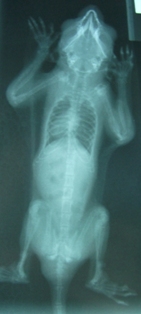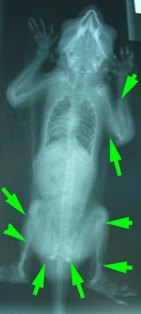Calcium Deficiency in Sugar Gliders
Calcium deficiency leading to nutritional secondary hyperparathyroidism (NSHP) is one of the most common problems of sugar gliders. NSHP, sometimes known as metabolic bone disease or MBD, is very common in young growing gliders fed an improper diet. The diet may be deficient in calcium, have too much phosphorus, not enough vitamin D3, or some combination of these problems. The bones never mineralize, and end up weak and easily broken. A sugar glider on a bad diet may appear perfectly normal right up until the time you find it paralyzed at the bottom of it's cage due to a broken back. Sometimes, a sugar glider on a bad diet may show problems climbing or walking as a result of bones that broke from being too low in calcium, often known as pathological fractures. Other signs of a bad diet are gliders that are underweight and small for their age.
A radiograph will help your veterinarian diagnose your sugar glider. The bones that are low in calcium will be grey. In the radiograph below, the skull is much brighter than the rest of the skeleton because that is the last bone to lose calcium combatting the deficiency.


A sugar glider with NSHP. All of the bones other than the skull are not well mineralized. The green arrows on the right point to the many different pathological fractures on its arms and legs.
Occasionally, a problem with the kidneys can create similar signs, so it is important to have your sugar glider's blood tested whenever a problem with the skeleton is found.
Once your glider has been diagnosed with NSHP, you must realize you now have a special needs glider. It will likely have permanent changes in its skeleton as a result of the multiple pathologic fractures in its arms and legs, and it will be more prone to arthritis as it ages. It may never be able to climb normally, and may not be able to groom itself normally. If it cannot groom itself, you may have to clean its hind end with a warm wet wash cloth several times a day to remove the feces and urine that accumulates.
Your sick glider will need to be kept in a "hospital cage" in order to recover more quickly and prevent further bone injuries. It is important for this hospital cage to have smooth sides so that your glider cannot climb and remains at the bottom of the cage. A deep plastic storage container works well as a temporary hospital cage. A 20 gallon aquarium with a screen top is another good choice. Place food and water in shallow dishes on the bottom of its cage. Do not provide any climbing structures as the glider is not stable enough to climb. Minimize handling your glider to reduce the risk of further injuries.
Your doctor may precribe a calcium supplement such as calcium glubionate to be given by mouth twice daily for several weeks to months. Some pets need injections of calcium in addition to the oral medication. Some gliders may need weekly injections of calcitonin hormone and anabolic steroids if not showing significant improvement within 6 weeks.
Special liquid diets, such as Emeraid for Omnivores, may be needed to help improve your glider's nutrition while it is recuperating, and as a supplement until it learns to accept the new diet your veterinarian recommends.
NSHP can be a painful condition so many gliders will need a pain reliever like meloxicam.
You will need to change your glider's diet. Use a calcium carbonate powder (such as Zoo Med's Calcium with D3) dusted onto the crickets and other insects, fruits, and vegetables at every feeding. A multivitamin supplement with vitamin A and vitamin D3 (such as Zoomed's Reptivite with D3) should be used as a dust on the crickets and other insects and produce twice a week.
If your glider starts to tremble or if it starts to seizure, it is going to need a recheck and injections of calcium and other treatments as soon as possible. Seizures are emergencies and need attention right away.
Your veterinarian should recheck your glider within 1 to 2 weeks of starting on treatment. Your glider should have a radiograph after 6 weeks to check the mineralization of its bones. Be prepared for a lengthy treatment as many gliders take 3 to 6 months to recover. As mentioned above, gliders with severe NSHP, particularly ones with pathological fractures, may never be completely normal.



